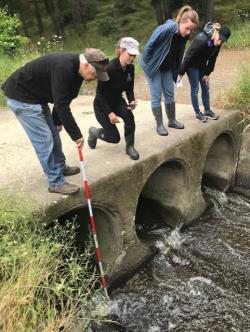Work to identify obstacles for our endangered fish begins
 Many native fish species are declining in the Greater Wellington region in part because they are having trouble swimming through our waterways - and Greater Wellington Regional Council and Porirua City Council are partnering to address the issue.
Many native fish species are declining in the Greater Wellington region in part because they are having trouble swimming through our waterways - and Greater Wellington Regional Council and Porirua City Council are partnering to address the issue.
The two councils have contracted students to assess the health of local Porirua streams, including locating potential barriers to fish passage. All data is being entered into a centralised national database via the app "NIWA Citizen Science".
Barriers found so far include man-made structures such as culverts and historic water supply weirs which span the width of a stream and may be difficult for some fish species to climb or swim over.
Greater Wellington's Senior Biodiversity Advisor Katrina Smith says that many of the 50 native freshwater fish species in New Zealand are threatened. "Around one third of these species spend time at sea to complete their lifecycles," says Katrina. "They need to be able to move between freshwater and marine environments without restriction."
Katrina adds that non-migratory species also need to be able to maintain free movement in rivers and streams to access habitats.
"Some of our native fish are good climbers and have the ability to get places that are harder to access," says Andrew Gray, Landscape Architect at Porirua City Council. "However, others are declining or endangered because they aren't able to climb past barriers as well."
Once the initial assessment has been completed the councils will consider next steps to help fish get past the barriers.
"Many of these fish are nocturnal, so people don't even realise they're there," says Katrina. "We need to work together to ensure they don't become extinct."
Get in touch
- Phone:
- 0800 496 734
- Email:
- info@gw.govt.nz
